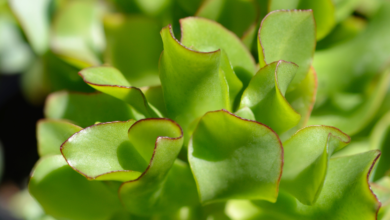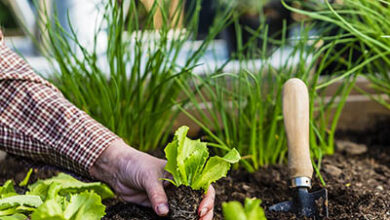Remember that there are two varieties of Chlorophytum capense, and you need to distinguish one from another by observing the leaf colors.
Generally, it has solid green leaves with white star-shaped flowers with six petals.
However, there is another variety called Chlorophytum capense “Variegated Leaf.” This variety has green leaves with white stripes at the center.
Remember that you may often confuse it with Chlorophytum comosum variety.
So, look for the plantlets because Chlorophytum capense does not have hanging plantlets like Chlorophytum comosum.
Use a well-drained potting mix for growing this plant, and avoid placing the variegated one under direct sunlight.
In addition, you also need to avoid using tap water for watering this indoor plant.
You can also propagate it from its produced spiderettes. If you notice the tiny spiderettes, don’t separate them too quickly.
Instead, let them remain attached to their mother plant.
After a few weeks, place them in a good mix of well-drained soil in a small pot close to the parent. Water the soil properly, and they will develop the roots.
Chlorophytum Comosum
The leaves of these plants have similar variegation to the Dracaena varieties.
You can find these evergreen flowering plant types in tropical and subtropical regions of Asia.
This plant can reach around 60 cm tall, and due to its cascading nature, we suggest you plant them in a hanging pot.
The tuberous and fleshy roots can grow a maximum of 4 inches long, and each leaf can be around 45 cm tall with green and white leaves.
This tropical plant produces beautiful flowers in its long branches.
This species is extremely easy to grow because of its fewer needs. Interestingly, this particular species has a lot of varieties because of different variegation.
The flowers are mainly green or white-colored and form an attractive boat shape at the tips.
These plants are straightforward to grow because of their fewer needs.
Interestingly, Chlorophytum comosum comes up with many varieties, such as Chlorophytum comosum ‘comosum‘, Chlorophytum comosum ‘sparsiflorum,’ Chlorophytum comosum ‘bipindense,’ Chlorophytum comosum ‘bonnie,’ Chlorophytum comosum ‘vittatum,’ and so on.
Each of them can be distinguished easily by their variegation type.
For example, C. comosum ‘comosum‘ has narrow leaves with strap shape, ‘bipindense‘ variety has petiolate and broader leaves with stripes at the underside, and ‘sparsiflorum‘ has a narrower base and doesn’t have a petiole.
Chlorophytum Comosum var. Comosum
It is the most common variety of Chlorophytum plants. During the blooming period, this plant produces small star-shaped white flowers.
There are around six petals that keep spreading freely.
Although comosum variety is drought tolerant, you may show brown tips or enclosed leaves when there is a lack of moisture.
That’s why we recommend you keep the soil evenly moist for growing them.
This plant prefers indirect medium-light, and direct sunlight can scorch the leaf tips. It is better to keep them under the filtered sunlight.
If you live in a tropical region, there is no need to worry about humidity.
Still, those who live in the arid areas must maintain a moderate to high humidity level for this spider plant.
You may either use a humidifier or mist the leaves to increase humidity.
Avoid using tap water because it often contains fluoride or chloride that can ruin the beauty of the foliage.
Chlorophytum Comosum var. Atlantic
Like most other spider plants, this one also has green and white leaves with white at the center and green at the edge.
Growing it in a hanging pot is ideal because of its appearance. It can grow 25-40 cm tall if it receives sufficient space.
These plants can be root bound, so you may have to repot them after two or three years.
Don’t forget to mix coarse materials, coco peat, and peat moss into the soil because these materials will improve the drainage and water retention capacity.
This species prefers thriving in moderate to high humidity levels, and to enhance the humidity level, you can mist the leaves with water or use a humidifier.
Chlorophytum comosum “Atlantic” likes to grow in warm conditions. You can move them under the warm spot and bright sun if you live in a cold climate.
You should fertilize them from spring to the later summer as these plants grow in this period actively. During the blooming period, these plants create white flowers.
Chlorophytum Comosum var. Vittatum
Like the other varieties, it is also popular because of Chlorophytum comosum var’s leaf pattern.
Vittatum is native to subtropical and tropical climates because of the warm temperatures and moderate to high humidity levels.
This plant can reach nearly 10 cm to 50 cm in height and width if you can provide it with sufficient room.
This clump-forming herb has beautiful leaves with white stripes at the center and green margins.
The leaves have an excellent arch and form like a fountain. They produce fascinating small white flowers on thin stalks during the blooming period.
You should plant Chlorophytum comosum var. vittatum in a well-drained potting mix and ensure sufficient room for their growth.
The temperature should be warm, and the humidity should be moderate. You should place this tropical plant in the shade as it likes shady locations.
Exposure to the direct sun can damage the leaf color for a prolonged period.
If you notice the baby spider offsets, you should carefully separate them from the mother plant.
You should avoid using tap water that contains fluoride as it can damage the leaves.
Instead, you can use distilled water or store rainwater for this spider plant.
During the spring, which is considered their growing period, you need to feed them with liquid fertilizer.
Avoid using any chemicals as they are harmful to the garden. Also, you should provide them with enough space to grow.
Chlorophytum Comosum ‘Variegatum’
This spider plant grows quite fast if it receives favorable conditions.
This plant can reach nearly 50 cm tall and is native to southern and tropical zones in Africa.
This houseplant is extremely easy to grow, and people grow it mainly because of its variegated leaves.
It has light green and white leaves with green at the center and white at the edge. The foliage absorbs harmful chemicals present in the air.
This spider plant needs sufficient space to grow. They are best planted in a hanging pot in the living or study room.
Remember that many people confuse this variety with “vittatum” cultivar. You should carefully observe the foliage pattern to distinguish them.
Vittatum cultivar has white leaves with green margins and white stripes at the middle.
You don’t have to feed it during the winter because, in this period, the plant becomes dormant.
You may apply liquid fertilizer during the spring and summer to encourage their growth. Fertilize them once every two weeks.
Chlorophytum Laxum
This plant is one of the easiest species to grow as a houseplant.
It has long, arching, and attractive leaves that are pretty stylish and add a soothing touch to the room. This spider plant is ideal for growing in a small pot.
Plant this species in well-drained soil and add organic materials to it. Avoid placing these varieties under the direct sun, damaging the leaves.
However, if you notice pale leaves, you can move them to a bright spot for them to ensure the spider plant receives more light.
Under intense light, the white margins can be damaged.
You don’t have to worry about the insects but look for the mealybugs as they are pretty hardy and hard to eliminate.
The spider plant is susceptible to a few diseases, and black leaf spot is the most common problem.
You can either use the seeds or separate the babies from the parent plant for propagation.
Feed this beautiful plant once every two weeks during summer and spring.
Chlorophytum Viridescens var. Hawaiian
The leaves have a beautiful green and white variegation during their earlier stage, but it fades away as the plant matures.
If you notice this single characteristic in a spider plant, then you can be confident that the plant is Chlorophytum viridescens “Hawaiian.”
The best season to plant this variety is spring to the summer. If you notice the baby plants, you need to separate them carefully and grow them in a small pot.
Water these babies appropriately. They will develop roots within a few weeks if they receive favorable conditions.
This variety of Chlorophytum grows at full potential when placed in a bright spot, appropriately watered, and fertilized at the right time.
Remember that this species cannot tolerate direct sun like the others. Therefore, you should keep them under the dappled or indirect light.
Keep the soil evenly moist, or the leaves will become narrower to reduce their surface areas.
Hawaiian spider plant grows quite fast, and it may reach up to 30 cm tall if provided sufficient room.
Chlorophytum Plant Care Guide
Chlorophytum plants have a few demands, but their beauty may ruin if you fail to fulfill their needs.
Let’s take a look at their basic requirements for growing indoors.
Light
You may keep them under direct sunlight in the morning for a few hours. You need to place them in a place that receives indirect light.
We suggest you put them at the east-facing window so that the plants get direct sunlight during the morning.
You should move them to west-facing windows during the summer month to receive afternoon light, which is fine.
Soil
For preparing the soil for Chlorophytum plants, you should carefully mix inorganic and organic materials.
Inorganic materials are perlite, vermiculite, pumice, etc., while organic materials are coco peat, peat moss, dead leaves, etc.
Use more organic materials to enhance the water retention capacity of the potting mix.
Water and Fertilizer
If you ever see that the leaves of spider plants are curling or closing, you have to supply water immediately because it is the first sign that the plants are not getting water.
If this condition persists, then these beautiful plants may die. Use distilled water for watering these plants.
If you use tap water for them, make sure that it is free from fluoride. Fluoride makes the leaf tips brown, which is indeed disturbing.
Avoid providing them excess water because it will create inundated conditions if your container doesn’t have drainage holes.
Spring and summer is their growing period. That’s why you should feed them with a balanced fertilizer during this time.
Feed them once every two weeks with liquid fertilizer. However, you may also apply inorganic fertilizer to these ornamental species.
Temperature and Humidity
Average temperatures for growing Chlorophytum plants range between 65 and 75 degrees Fahrenheit, and these tropical plants grow best in this range.
If you live in a colder region, try keeping them in a warmer place because they don’t like being exposed to less than 50 degrees Fahrenheit.
Humidity is an essential factor in maintaining its beauty. At lower humidity levels, the leaves may turn brown.
If you ever notice brown leaves in spider plants, you should increase the humidity by misting the leaves or using a humidifier.
Repotting and Propagation

The roots of spider plants can be dense and form root balls that need much room to grow further. Hence you should repot them in a larger container.
Make sure that there is a minimum of 2 cm area left between the roots and the bottom of the pot.
People can easily propagate these plants, and it is an exciting activity among the gardeners.
The mature plant produces new offsets that can be carefully separated from the mother plant.
You need to propagate the variety by planting these new plants in the soil.
The spider plants’ babies are called spiderettes, which grow from the stems. Gardeners can also propagate them by using their seeds.
Common Problems with Spider Plants

Spider plant is undoubtedly one of the most beautiful indoor plants because of its beautiful variegation and green and white margins.
However, a few common problems can ruin this beauty, and it becomes pretty hard to identify and tackle this problem.
Let’s look at some of their everyday issues and how you can get rid of them.
Brown leaf tips
Brown leaf tips can occur for three main reasons: too much chlorine or fluoride in the water, low humidity, and too much sunlight. These are the most common problems that gardeners face.
Yellow or pale leaves
Leaves will turn yellow or pale if the plants don’t receive sufficient light. Provide them with more light to solve this problem.’
Enclosed leaves are signs that the plants aren’t receiving enough water. They close their leaves to reduce moisture loss from the respiration process.
Black leaves
Leaves may turn black if there is excess water. Try improving the drainage conditions or reducing the watering frequency.
There are a few common diseases like root rot, fungus gnats, leaf tip burn, bleached foliage, etc.
These diseases can frequently occur if you keep the soil soggy for a prolonged period.




